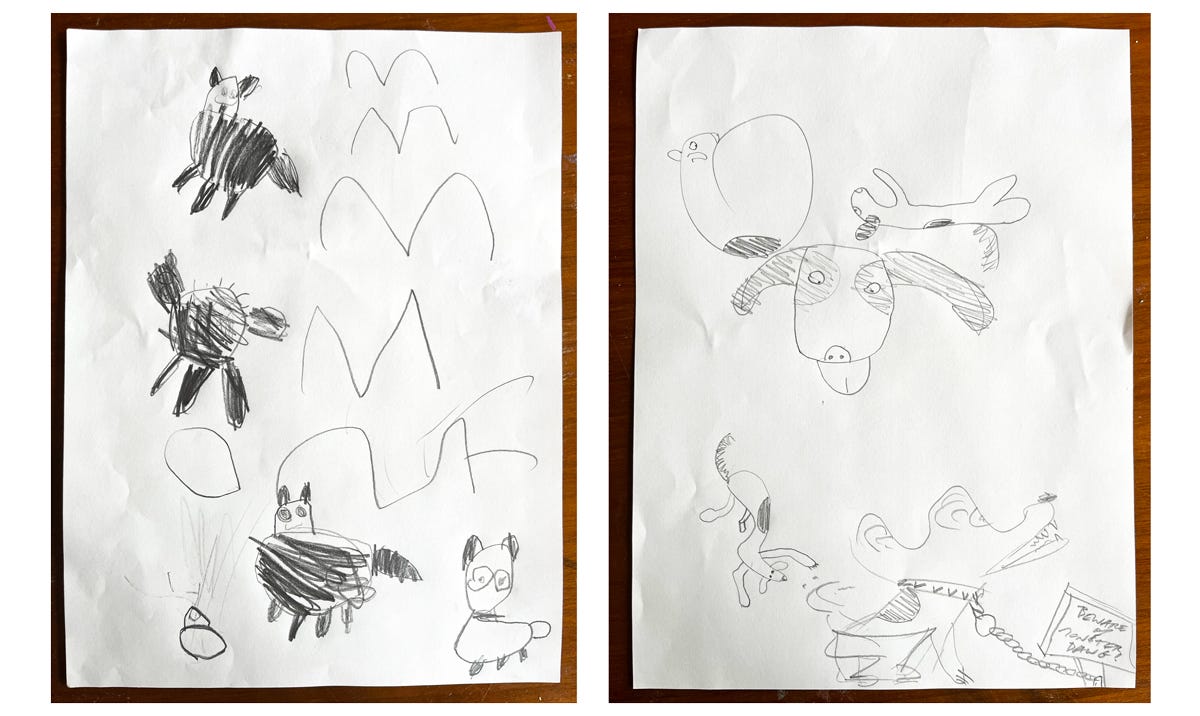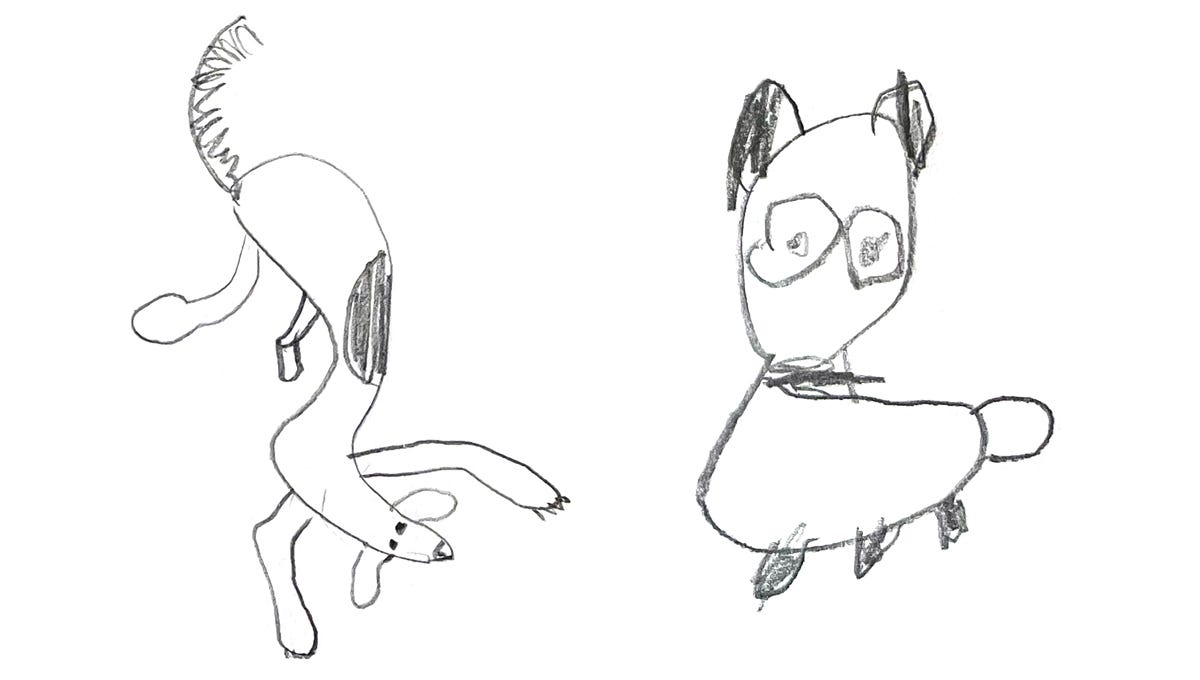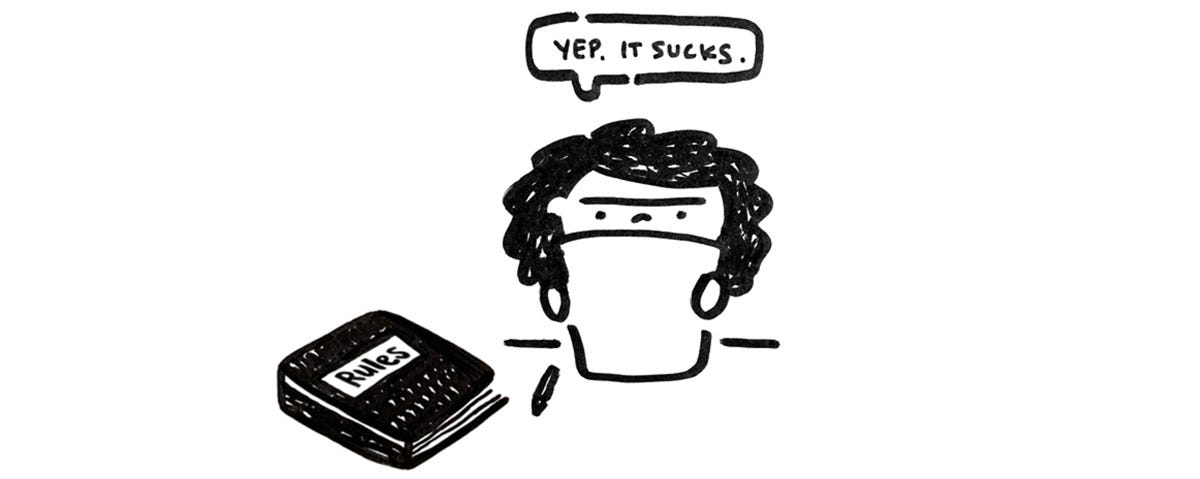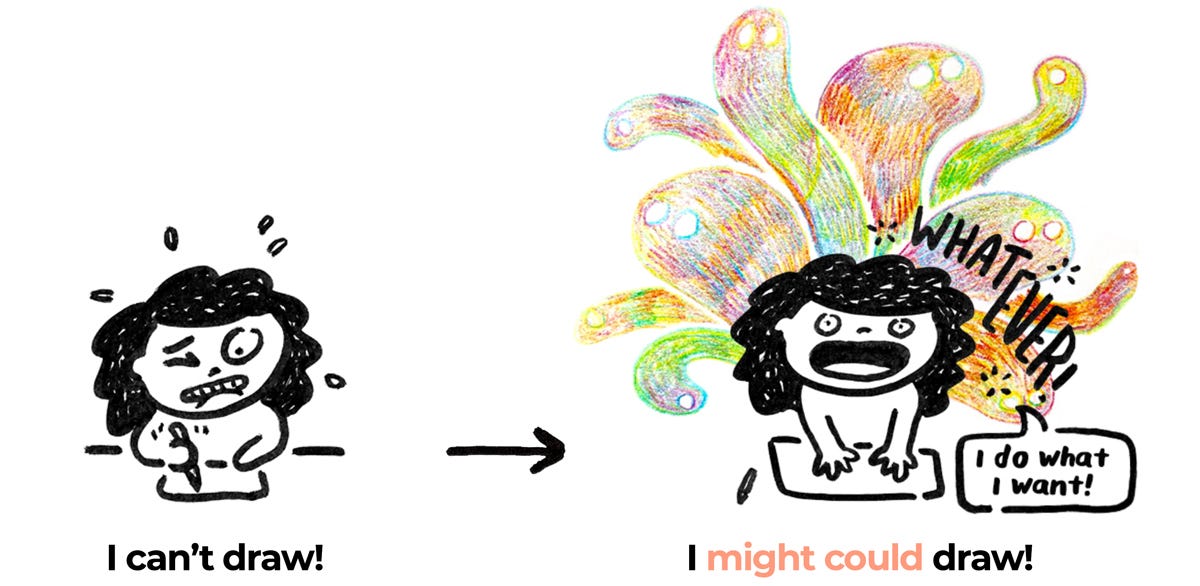I Can't Draw! (Part 3): Drawing Squiggle Cats + Dogs 🐱🐶🌀
A 3-Part Drawing Workshop
Note: This is Part 3 of a 3-part workshop called I Can’t Draw! You can read Part 1 here and Part 2 here.
Ok, ok, ok! So far, I’ve explained my Might Could Mindset theory and showed you how it can be used to draw the three most dreaded subjects: faces, hands, and horses. Now, it’s your turn! So grab a pen and let’s draw!
🚨 Important Note: For this exercise to work best, don’t look ahead at the instructions before you begin! Complete with Step 1 before you continue reading! C’mon, it’ll be fun!
Step 1: Mess Up the Page
All right, so you’re probably nervous about making that first mark. The page is so blank and pristine and hasn’t been messed up yet, and the first mark could ruin everything! Where do we start? How do we decide what to draw first?
Let’s kick down that Blank Page Syndrome and Perfectionism with a big ol’ squiggle. Just take your pen—whatever pen you have near you is fine—and make a random squiggly mark on the page.
I want you to draw a total of 5 squiggles at varying sizes. Keep them simple and be quick—don’t overthink it! This doesn’t matter at all, it’s just nonsense squiggles on a page! I’ll give you just few more seconds to do this.
Step 2: Are You a Cat or Dog Person?
Ok, now one thing I believe about learning to draw is that drawing can be a very personal activity, and discovering your unique way of drawing is often also a matter of discovering yourself. It requires some introspection and self-awareness. It requires having something to say, taking a stand, and communicating the very essence of what it is to live as a human being. So with that in mind, I have a very important philosophical question for you:
Are you a DOG person or a CAT person?
Great. Now that we’ve settled that deeply meaningful distinction, we can move on to Step 3.
Step 3: Squiggle Cats or Dogs
Surprise! I tricked you. Those squiggles you drew earlier actually do matter. They are now the beginning of your drawings!
First, I want you to look at your squiggles. Do you think you could turn those squiggles into cats? Or, if you answered our question in a more canine-orientation, could you turn your squiggles into dogs? We might could, yeah?
Look at one of your squiggles and try to see the shape of a cat or dog in it. Perhaps you can see the suggestion of a head or the wisp of a tail. Could it be the loose shape of a cat stretching or a dog yawning? Maybe it’s running or sleeping or licking? Try adding a pair of eyes to a squiggle. Now add four legs. Now add a tail and ears. There! You drew a cat!
What’s that, Inner Critic? Your drawing doesn’t look like a cat? Says who?! You can’t tell me what my cat can look like! Silenzio, Bruno! (Thanks, Luca.)
Ok, give yourself about 10 minutes to work on making your squiggles into cats or dogs and then we’ll reconvene. Maybe start the timer and play some music while you draw. I’m gonna do it with you now!
.
.
.
Ok, that’s our timer!
We Did It!
Here are some of my Squiggle Cats I drew in my sketchbook! How silly and fun! Yours probably look very different and that’s great—everyone will create totally unique cat drawings with this exercise. That’s kind of the point. To show you some of the range of endless possibilities, here are a few examples from people who attended my in-person workshop:
Brilliant! I just want to pull out a couple of drawings from those two pages to highlight how original and unique these squiggle pets can be:
So fantastic! Now you may be wondering why we did this drawing exercise. Or perhaps you’re feeling self-critical about the squiggle pets you just created. So let’s look at the why behind this way of drawing and try to reorient your mindset.
What’s the Point?
Drawing these squiggle cats and dogs helps us draw in a way where we aren’t being self-critical and overthinking, and instead look at things more abstractly. It helps us focus more on the process of creating, rather than the final product. And it smashes the belief in the binary right or wrong way of drawing something, opening our minds to the possibilities of our imagination.
If I had just told you in Step 1 to draw a cat or dog, would you ever have drawn it like you did here? Probably not. But now, because you approached it without the extra weight of those artistic obstacles, you’ve drawn a completely original page of cats or dogs! No one has ever drawn a cat or dog before like you just drew. They are completely unique.
I firmly believe that when people say they can’t draw, what they really mean is they can’t draw the way they think they’re supposed to draw—the way they’ve been told is the “right” way to draw.
My Biggest Advice
So here’s my biggest piece of advice: when you’re drawing, you gotta slam the door in your inner critic’s face, and tap into your inner rebel instead.
We have to follow rigid rules so often in life, so why not use our art as a time to break the rules and do what we want? No one can tell you how to draw. People may try to tell you something is right or wrong—I’ve had people tell me all sorts of things about my art are wrong, including how I hold a pen—but those people are only trying to protect their own way of drawing and make themselves feel better about how they choose to draw.
Making art isn’t about right or wrong. Making art is about playing around, exploring the possibilities, and growing and learning with every piece we make. To me, there is no objectively good or bad art. It’s all subjective—it’s all up to you and what you think.
And really, making art isn’t even about the art-part at all. It’s about the making. It’s about the process of drawing and creating and learning to fall back in love with drawing and remembering how fun drawing can be when we stop worrying about trying to do it the right way.
There is no right way to draw. There’s only drawing or not drawing.
So… Which Is It Going to Be For You?
Which do you choose: drawing or not drawing? You can, you can’t, or you might could? The ball is in your court now—it’s up to you to choose.
I firmly believe that everyone can draw, and not just draw, but draw in their own way, with their own artistic style. And I’ve learned a lot about how to do that over my years of making and teaching art.
The most important things I’ve learned:
The artistic journey is a lifelong journey. As self-taught artists, we never really graduate art school—we’re always learning and growing and evolving.
You can teach someone how to be an artist by building up their artistic mindset and facilitating art exploration.
Learning and teaching how to make art isn’t just about information, it’s about action and people. We learn by making. And we learn more by making together and sharing what we’ve learned with each other.
Share Your Work With Us!
I really want to see what you came up with for our squiggle pet drawing exercise! If you’d like to share your drawings with us, you can snap a photo and upload it here in this Substack Chat thread! I love seeing them!
Welp, that’s the end of this workshop series, I hope you liked it—let me know what you think and if you’d like to see more stuff like this!
Thanks for reading and I hope to see your drawings in the Chat!
<3,
Christine











Keep up the great work Christine!!
Christine, thanks to one of your skillshare classes. I do my dog poses each day.